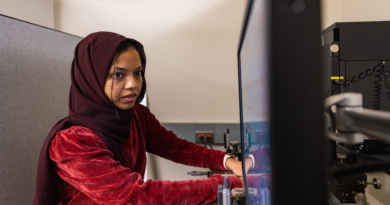Next-generation AI semiconductor devices mimic the human brain – Tech Xplore
Click here to sign in with or
Forget Password?
Learn more
share this!
137
Twit
Share
Email
March 29, 2024
This article has been reviewed according to Science X’s editorial process and policies. Editors have highlighted the following attributes while ensuring the content’s credibility:
fact-checked
peer-reviewed publication
proofread
by DGIST (Daegu Gyeongbuk Institute of Science and Technology)
A research team led by Prof. Kwon Hyuk-jun of the DGIST Department of Electrical Engineering and Computer Science has developed a next-generation AI semiconductor technology that mimics the human brain’s efficiency in AI and neuromorphic systems.
The advancement of AI has stimulated a rapidly growing demand for energy-efficient semiconductor technology with a fast operational speed. However, traditional computing devices with their von Neumann architecture and separate computing and memory units have speed and energy efficiency shortcomings associated with data processing bottlenecks. Consequently, research on neuromorphic devices that mimic biological neurons’ simultaneous computing and memory functions is gaining attention.
Against this backdrop, Prof. Hyuk-Jun Kwon’s team developed synaptic field-effect transistors using hafnium oxide, which has strong electrical properties, and thin layers of tin disulfide. This resulted in a three-terminal neuromorphic device capable of storing multiple levels of data in a manner similar to neurons.
The research successfully replicated biological characteristics such as short- and long-term properties, yielding a highly efficient device that responds 10,000 times faster than human synapses and consumes very little energy.
Prof. Hyuk-Jun Kwon of the Department of Electrical Engineering and Computer Science said, “This research marks an important step toward next-generation computing architecture, which requires low power consumption and high-speed computation. We have developed high-performance neuromorphic hardware using two-dimensional channels and ferroelectric hafnium oxide, and the innovation is expected to have various AI and machine learning-related applications in the future.”
The research is published in the journal Advanced Science.
More information: Chong‐Myeong Song et al, Ferroelectric 2D SnS2 Analog Synaptic FET, Advanced Science (2024). DOI: 10.1002/advs.202308588
Explore further
Facebook
Twitter
Email
Feedback to editors
Jul 13, 2024
0
Jul 12, 2024
0
Jul 12, 2024
0
Jul 12, 2024
0
Jul 10, 2024
0
Jul 13, 2024
Jul 13, 2024
Jul 12, 2024
Jul 12, 2024
Jul 12, 2024
Jul 12, 2024
Jul 12, 2024
Jul 12, 2024
Jul 12, 2024
Jul 11, 2024
Mar 4, 2024
May 20, 2022
Nov 1, 2023
Dec 19, 2023
Jun 1, 2023
Jan 29, 2021
Jul 13, 2024
Jul 12, 2024
Jul 12, 2024
Jul 12, 2024
Jul 11, 2024
Jul 11, 2024
Use this form if you have come across a typo, inaccuracy or would like to send an edit request for the content on this page. For general inquiries, please use our contact form. For general feedback, use the public comments section below (please adhere to guidelines).
Please select the most appropriate category to facilitate processing of your request
Thank you for taking time to provide your feedback to the editors.
Your feedback is important to us. However, we do not guarantee individual replies due to the high volume of messages.
Your email address is used only to let the recipient know who sent the email. Neither your address nor the recipient’s address will be used for any other purpose. The information you enter will appear in your e-mail message and is not retained by Tech Xplore in any form.
Daily science news on research developments and the latest scientific innovations
Medical research advances and health news
The most comprehensive sci-tech news coverage on the web
This site uses cookies to assist with navigation, analyse your use of our services, collect data for ads personalisation and provide content from third parties. By using our site, you acknowledge that you have read and understand our Privacy Policy and Terms of Use.
